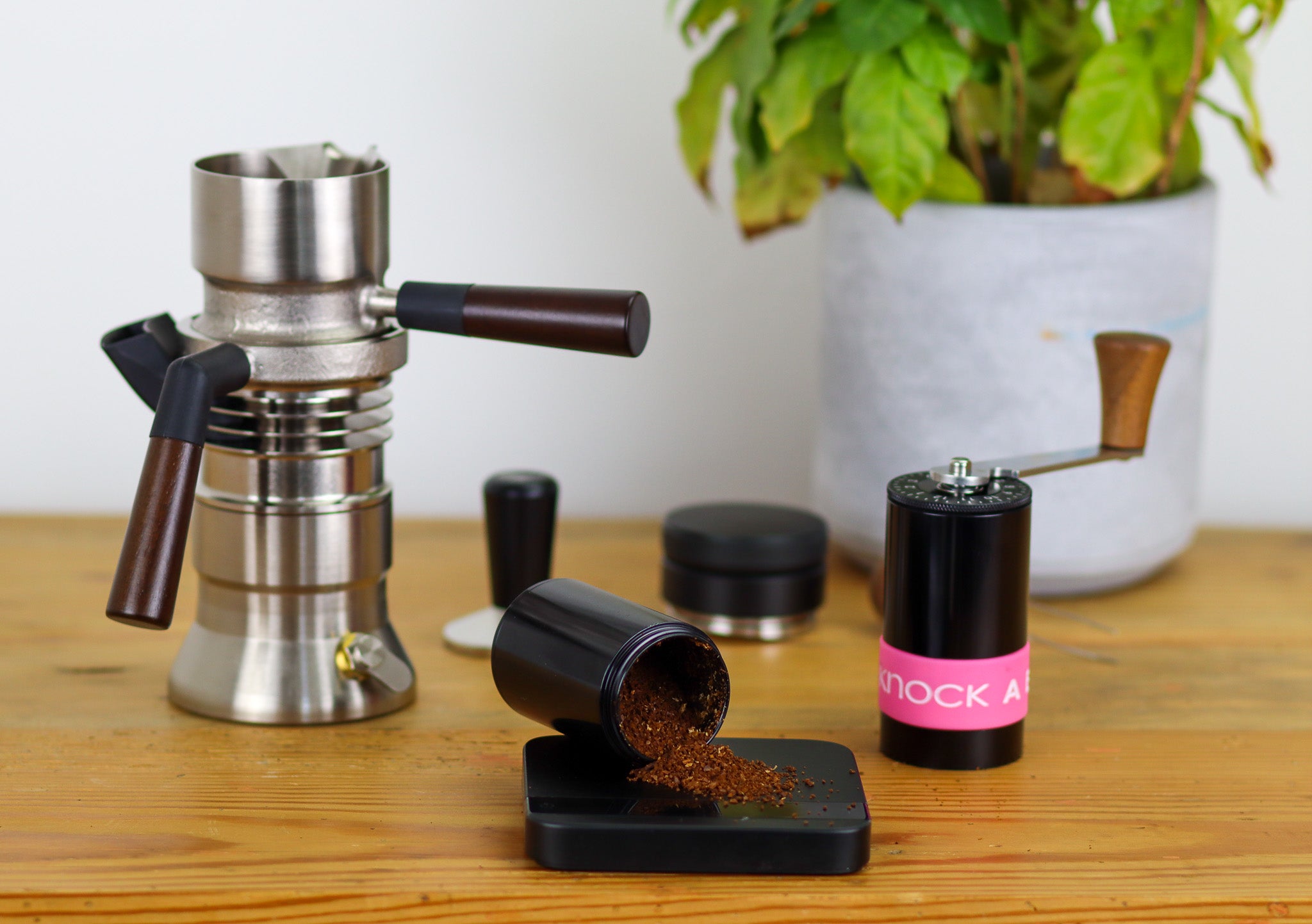Contents:
1. What Do We Mean By Grind Size
2. Why Do We Grind Coffee in the First Place?
3. Always Grind Your Beans Just Before You Use Them
4. Burr Grinders and Blade Grinders
5. How To Tell Which Grind Size Is Righ
6. Keep Adjusting, Keep Experimenting
7. Suggested Settings and Grinders
Adjusting and defining a specific grind size is one of the best ways to uniquely tailor the flavour your espresso shots, and get the most out of your coffee beans in general. Different beans require different grind sizes depending on their roast level, freshness and origin to name just a few variables. It's not always easy to know where to begin when you get your freshly roasted coffee beans, so we've put together this helpful guide to give you some pointers to getting that perfect cup of coffee.
What Do We Mean By Grind Size
When referring to coffee 'grind size', we're talking about how big (coarse) or small (fine) the individual coffee grounds are. Why is this important? Well, it is one of the main factors that influence the brew water's contact time with these particles and how quickly they dissolve compounds from the coffee particles and turn them into a delicious cup of coffee. Finding that sweet spot can be a challenge; grind too fine and you risk over-extracting, grind too coarse and you'll end up with an under-extracted brew.
Why Do We Grind Coffee in the First Place?
There is nothing better than the smell of freshly ground coffee, but why do we even grind it in the first place? Grinding coffee into smaller particles will increase the surface area through which the brew water can interact it. One coffee bean contains a fixed amount of soluble compounds, however when ground, the water will have more surface to interact with and extract from; thus producing a much richer and fuller coffee flavour. This is true for different brewing methods, whether you're using the 9Barista espresso machine or a pour-over, and will affect the speed through which water is able to travel through your grounds. Finer coffee will have a slower extraction time, and coarser coffee will be faster.

Always Grind Your Beans Just Before You Use Them
When it comes to getting the best out of your coffee, every coffee connoisseur will recommend using recently roasted and freshly ground beans. But why is pre-ground coffee not ideal for maximising flavour?
Coffee beans are naturally full of chemical compounds and trapped gases that give your brew its flavours and aromas. When you grind the beans, you increase the surface area which is exposed to the water during the brewing process, and thereby increase the extraction of these compounds.
However, as soon as the coffee has been ground it will immediately begin to oxidise and dissipate some of the chemical compounds into the air, which leads to stale grounds, and a less flavourful espresso. That's why you can almost always taste the difference between coffee grounds bought in the supermarket and ones you've freshly ground at home. So, what can we do to prevent our coffee from degrading? Unfortunately, there is nothing which will totally stop the gases and compounds from dissipating/oxidising, but we can slow it down. The most important thing is to buy freshly roast coffee and to grind the beans just before you use them. Storing ground coffee in a vacuum sealed opaque container will help keep your coffee as fresh as possible too.
Burr Grinders and Blade Grinders
Of course, not all grinders are made equal and it's important to understand what to avoid if you're keen to get the perfect grind size. In the coffee world, there are two main types of grinders: burr and blade grinders. A blade grinder works in much the same way as a food processor; it will use a spinning blade to speedily chop the coffee beans into small particles. The longer you expose your beans to that blade, the smaller and smaller they will become until they are 'dust-like'.
On the other end of the spectrum, we have burr grinders. Long hailed by coffee enthusiasts, and professionals alike as the better of the two for quality and consistency. Burr grinders work by rotating two ceramic or metal discs (or burrs) against one another - some are flat, and some are conical depending on the type - with sharp teeth. The grind size is determined by how close, or far apart these discs are from each other. For an espresso grind, you'd want them to be fairly close to get the fine grounds needed in that particular brew method.
The main reason most baristas will prefer this grinder over a blade grinder is down to consistency, both in the shape of the grounds and the size. With a blade grinder the only control over the end result is time; blend for longer and you'll get a fine grind, blend for shorter and you'll get a coarse grind. Additionally, your coffee beans will not always be exposed to the blade itself, sometimes it will be suspended in the air around the blade or rubbed up against the side of the blender walls, which results in all sorts of weird and wonderful shaped grounds.
A burr grinder, on the other hand, allows you to control the grinding process to a much higher degree of precision. This ultimately means you can achieve a much more consistent grind size and shape.
However, that's not to say that even if you only use burr grinders, you'll always get a perfect consistency. There will always be some that have ground finer, and some coarser - there will always be some variation to the size and shape of the coffee particles. Higher quality grinders will be able to limit this and will produce a much higher level of consistency, and is probably the single best thing you should invest in once you've begun your home espresso journey.
How To Tell Which Grind Size Is Right
Knowing about the importance of grind size and its affects on the flavour of your brew is all well and good, but how do we know when we've found the right grind size for our chosen brew method? Some grinders will helpfully label the appropriate range to use, but not all. So here's a general rule for some brew methods:
- Espresso Makers- This is ground very finely, and is the best grind size to use for the 9Barista Espresso Machine. Brewing in espresso conditions, exposes the grounds to high pressures so we need them to provide resistance or we risk under-extracting and having a very fast shot. By grinding fine (you'll looking for the consistency of table salt), this forces the particles close together and increases the surface area through which the pressurised water interacts, increasing extraction.
- Pour-over Brewers - This is a (generally speaking) medium grind size - this has the consistency of grains of sugar, however this all depends on how much coffee you're making. If you're making a big batch for your whole team, you'll grind coarser but with a larger dose. Conversely if you're making one just for you, grind finer with a smaller dose.
- Cold Brew - Since this brew method happens over a long period of time, with a large dose, you would aim to for coarse grounds - these look similar to chopped up chocolate.
Keep Adjusting, Keep Experimenting
As with everything relating to flavour, finding the perfect grind size is down to you knowing how you like your coffee to taste. Generally speaking you'll want to stay within the parameters discussed above, but you can finely tune your grinder to your specific taste.
The lower the percentage of dissolved compounds in your final cup, the more acidic and sour your brew will be, and the higher the more bitter. So if you're finding that your espresso is tasting particularly bitter, you know you need to grind coarser on your next extraction. Have fun with it! It can be challenging finding the perfectly balanced cup, but it's worth doing. Of course, it's worth stating that every coffee is unique in its own flavours and aromas, and that the roast level will also impact the final taste and how you should grind.
Suggested Settings and Grinders
We’re lucky enough to have some fantastic customers who have given us feedback on their grinders, recommending what works well for them. Combined with our own experience we can recommend the following settings as good starting points when first brewing with your 9Barista.
Remember, if in doubt start with a coarser setting and gradually go finer until you hit a 25 – 30 second extraction time. The ideal grind setting will depend on the coffee you’re using, so you may need to make a few of your own adjustments. Broadly speaking, go finer if the coffee tastes too acidic. It's also important to remember that the beans being used, and the freshness of those beans, also have a big effect on the grind size required. As such, these settings are purely intended as a rough guide.
- Comandante C40: 7 clicks
- Comandante C40 with Red Clix: 20 clicks
- Niche Zero: 15
- Kinu M47: 1.1 to 1.2 clicks
- Kinu Simplicity: 12 to 14
- Barazta Encore: 7
- Knock Aergrind: 1.1 to 1.3
What are your thoughts? What's your favourite grinder? We'd love to hear from you!














